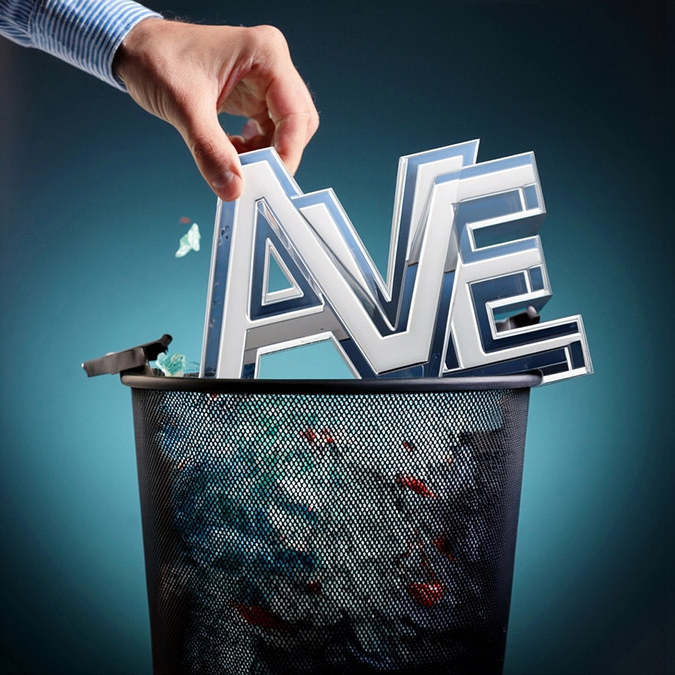Why AVEs are the wrong answer to the wrong question if you want to know how PR has helped you achieve your business goals

In previous posts I’ve explained how best practice Public Relations is about helping your organisation achieve its goals via contributing to Business and Communication Outcomes and Impacts, media coverage is the Means and not the End of PR and Media Relations towards achieving those goals and why AMEC’s Barcelona Principles are the global gold standard for setting appropriate ways to quantify how effective your communication has been and which metrics to use.
Here I want to go further into Principle 5 - “Invalid measures such as advertising value equivalents (AVEs) should not be used. Instead measure and evaluate the contribution of communication by its outcome and impact”.
What AVEs are
First I need to explain what AVEs are and how they’ve been used to measure the value of communication. When I started working in Public Relations in 2011, I was taught that AVE was the way to show the client the value of the media coverage we’d generated.
We would literally buy the newspapers we’d pitched our client’s story to, collate the coverage into a report, measure its physical size and use the publications’ advertising rate cards to calculate how much it would have cost to buy that space as advertising and multiply that figure by three – to represent the added value of the story being told by media rather than the client.
From that we could also calculate an ROI (Return on Investment) for the story and the campaign it was part of – so the client could compare its value versus other forms of promotion they were doing, usually more expensive, making the PR look good value by comparison.
Why AVEs are popular with C-Suite & PRs
This is why AVE was and is a popular PR metric for many clients, especially those accountable for their organisation’s finances – ROI is a metric they already use and accept.
The problem is that it and the way it’s been calculated via an AVE are the wrong answer to the wrong question if you want to know how PR has helped you achieve your business goals.
Why AVEs aren’t a true metric of communication value

Image created using Adobe Firefly
If you rightly ask a PR professional ‘How has the communication I’ve paid you for help me with my quarterly targets?’, answering ‘This is how much it would have cost you as advertising’ and ‘Here’s the ROI of what we did’ aren’t appropriate answers.
Also, not all business goals can be measured with quantitative metrics. That’s why Principle 4 is “Effective measurement and evaluation of communication require qualitative and quantitative analysis.”
So if you want to know whether your organisation’s reputation with its target stakeholders has improved, numerical metrics such as ROI aren’t appropriate. This is why the UK’s Government Communication Service (GCS) has its own communication evaluation standard and process called the GCS Evaluation Cycle – to allow public sector communicators to measure the effectiveness of their work against non-commercial goals.
Practitioners need to change
I was shocked recently to discover, via Stephen Waddington, that the 2022-23 ICCO World PR Report reported that 48% of UK organisations still use AVEs and that they’re “still used at the highest levels in corporate communications, tool vendors provide them within their platforms, and agencies sell them to clients.”
As Stephen says, “AVEs are entirely flawed as a management metric for the effectiveness of corporate communications and public relations practice. Ultimately, they're a contributing factor to public relations not being taken seriously as a management discipline. This is a systemic industry problem.”
So what needs to happen? Firstly, clients need to be educated about why AVEs aren’t a proper measure of communication value. Second, they need to challenge PR practitioners who use them to justify their fees.
Thirdly, all PR practitioners need to adopt and work to Barcelona Principles 4.0 – so the true value of Public Relations can be shown and its reputation improved through positive action.
I have and will continue to keep up to date with best practice as part of my weekly CPD.
© Alan S. Morrison, 2025
Alan S. Morrison gained his Master of Business Administration (MBA) postgraduate degree from the Open University Business School in 2003 and is one of the case studies for it.
At that time he was working as a senior Sub-Editor in a Scottish newspaper, following 15 years as a Reporter, Chief Reporter and News Editor.
In 2012, Alan launched his own communications company, ASM Media & PR, after entering Public Relations via agencies and credits the knowledge and skills he gained on his OU MBA as being instrumental in helping him career-change successfully.
His award-winning clients include a rugby charity with a Royal patron, Scotland’s largest independent lift company and a vintage lifestyle brand whose products are seen in scores of Hollywood movies and global TV shows.
The marketing campaign Alan created and helped execute for St Andrews Business Club was a Finalist in the 2019 Fife Business Awards.
Alan’s LinkedIn profile is here. Go here to find out more about his work.
August 2025
Would you like to contribute an article towards our Professional Knowledge Bank? Find out more.
